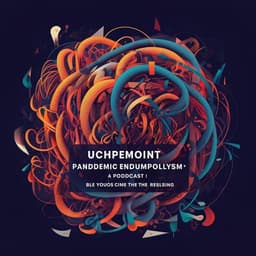
Interdisciplinary Studies
What is newsworthy about Covid-19? A corpus linguistic analysis of news values in reports by China Daily and The New York Times
S. Liu and H. Yu
Dive into the intriguing study by Siyang Liu and Hailing Yu, which explores how China Daily and The New York Times depict the Covid-19 pandemic news from their unique cultural and political perspectives. This research uncovers the contrasting approaches in representation, emphasizing positivity and self-representation in domestic coverage and varied nuances in international news.
~3 min • Beginner • English
Introduction
The study examines how news media, specifically China Daily (CD) and The New York Times (NYT), construct newsworthiness when reporting the Covid-19 pandemic, differentiating between coverage of the pandemic in their respective home countries and in other countries. Motivated by observed patterns of positive self-representation and negative other-representation in pandemic discourse and the relative lack of comparative empirical work across media systems, the research asks: (1) which news values are constructed and how in headlines and leads of CD and NYT reports about domestic and international Covid-19 news; and (2) which aspects of Covid-19 are emphasized or downplayed. The study integrates corpus linguistic techniques with news values analysis to address limitations of purely qualitative approaches and to contribute to understanding Self versus Other representation during a global health crisis.
Literature Review
Prior research indicates that media coverage is shaped by sociocultural and political contexts, with Chinese and Western media often framing Covid-19 differently. Chinese media emphasize positive themes, such as prevention, control, medical response, and recovery, alongside a mixture of globalism and nationalism that highlights China’s successes and support to others while criticizing Western responses. Western media frequently externalize the virus as a foreign threat, emphasize politicization (especially in US media), highlight economic impacts, and foreground ordinary people’s experiences. Comparative studies suggest Chinese outlets stress positive domestic responses, while US outlets focus on political conflict and negative tones in coping strategies and emotions. The ideological square framework predicts positive Self and negative Other patterns, observed across various countries’ Covid-19 reporting, though cross-national comparative analyses remain limited. In news values scholarship, Bednarek and Caple’s discursive perspective defines ten news values (Consonance, Eliteness, Impact, Negativity, Personalization, Positivity, Proximity, Superlativeness, Timeliness, Unexpectedness) constructed through discourse. Corpus-assisted approaches (keywords, collocations, concordances) have proven effective in identifying newsworthiness patterns across large datasets and cross-cultural contexts, though qualitative contextualization remains crucial.
Methodology
Data were collected from the websites of China Daily (https://www.chinadaily.com.cn/) and The New York Times (https://www.nytimes.com/) using the keywords 'virus', 'coronavirus', and 'Covid-19'. Constructed week sampling (Song and Chang, 2012) was employed over 1/1/2020–12/31/2021 by randomly selecting one day per week to build 15 constructed weeks. Reports were classified into domestic (CD on China; NYT on the US) and international (other countries) sub-corpora. Exclusions included items mentioning the keywords without focusing on the pandemic, items not tied to a specific country, and the small number of direct comparison pieces between home and other countries. The final dataset comprises 2572 reports (CD: 1360; NYT: 1212) and 96,125 words across headlines and leads only: CD-China (719 reports; 28,539 words), CD-Other (641; 24,921), NYT-US (775; 27,322), NYT-Other (437; 15,343). Headlines and leads were targeted due to their prominence in online news selection and their function in the inverted pyramid as the most newsworthy elements. Using Wmatrix, the authors conducted keyword analyses by reciprocally comparing each outlet’s domestic and international sub-corpora to produce four keyword lists. Keyness was calculated using log-likelihood (LL), retaining the top 100 per sub-corpus for qualitative analysis. Keywords were interpreted via concordance lines to validate links to specific news values, and when relevant, a keyword could map to multiple values; uninterpretable or non-differentiating keywords were excluded. Collocation analysis (LL statistic) complemented keyword and concordance analyses to reveal typical co-occurrences. Target audience assumptions followed Bednarek and Caple’s audience-dependency of news values, treating NYT’s audience as primarily American and CD’s as Chinese English-proficient readers (supported by Alexa audience statistics).
Key Findings
- Across all data, keywords pointed to six news values: Negativity, Impact, Personalization, Positivity, Proximity, Eliteness, and Superlativeness. No clear keyword pointers were found for Unexpectedness, Consonance, or Timeliness in this dataset.
- China Daily (CD):
- Domestic (China) coverage highlights Proximity (dense references to Chinese places from national to city/regional labels), Positivity (anti-virus actions and measures such as nucleic acid testing, vaccination administered, prevention and control), and Personalization (patients, residents; medical workers/teams/staff associated with positive actions). Eliteness is present but less emphasized than in international news; references to institutions (e.g., commissions, authorities) and President Xi often carry positive or neutral connotations.
- International coverage foregrounds Negativity and Impact (deaths, hospitalizations, lockdowns, restrictions; negative emotions like fears and concerns), Superlativeness (surge, spike, surpass(ed), topped, reached, nationwide indicating intensity and scope), and Eliteness (political leaders and institutions such as prime minister, Trump, Biden, White House, FDA, CDC). Positivity is de-emphasized, limited mainly to vaccine/vaccination developments.
- The New York Times (NYT):
- Domestic (US) coverage gives more prominence to Eliteness (political figures such as Trump and Biden, governors and mayors, recognized organizations like CDC/FDA, and notable experts like Fauci; party politics appear frequently) and Personalization (Americans, New Yorkers, children, students). Negativity/Impact are present but less emphasized than in NYT’s international coverage; examples include school(s) closures and travel industry impacts. Superlativeness is occasionally constructed (e.g., continued, far with comparatives) but not highlighted.
- International coverage foregrounds Negativity/Impact (lockdowns, restrictions; protests, flouting of rules), and Proximity (frequent references to culturally/geographically close countries/regions to US readers: Britain/UK, Europe, Italy, France, Germany, Spain, Canada, Australia, New Zealand; underrepresentation of non-Western regions). Positivity is present but not prominent (e.g., inoculation, approves, celebrate). Eliteness includes leaders and organizations (e.g., Boris Johnson, WHO, UN, AstraZeneca).
- Comparative patterns:
- Both outlets represent their domestic pandemic as less negative and impactful than their international coverage, indicating a tendency to downplay domestic negativity/impact.
- CD shows a stronger positive self-representation and negative other-representation than NYT, with domestic Positivity and international Superlativeness intensifying negative portrayals of Others.
- NYT’s domestic coverage is more politicized, focusing on political actors more than institutions; CD’s domestic Eliteness skews toward institutions (e.g., “commission”) more than individual politicians.
- CD highlights Superlativeness markedly in international coverage; NYT backgrounds Superlativeness across both domains.
- Dataset composition: 2572 reports; 96,125 words. CD: 1360 reports, 53,460 words (China: 719/28,539; Other: 641/24,921). NYT: 1212 reports, 42,665 words (US: 775/27,322; Other: 437/15,343).
Discussion
The findings address the research questions by showing that CD and NYT select and linguistically construct news values differently across domestic and international Covid-19 coverage. Both outlets foreground Proximity, Eliteness, Personalization, and some Negativity/Impact at home, but temper domestic negativity compared to international reporting, consistent with cross-cultural crisis reporting tendencies. CD’s domestic Positivity leverages war metaphors (fight against the virus) and emphasizes institutional actions and social solidarity (medical workers, supplies), supporting a positive Self image. In international coverage, CD intensifies negative Other-representation through Negativity/Impact and Superlativeness (surge, surpassed) and emphasizes political elites. NYT’s domestic news exhibits politicization through a strong focus on political figures and party politics, with Personalization often co-occurring with negative situations for ordinary people (e.g., Americans in distress). Internationally, NYT emphasizes Negativity/Impact and constructs Proximity via culturally/geographically close regions (Euro-American-centric focus), while giving comparatively less weight to Superlativeness and Positivity. Overall, the news value constructions reveal convergence in downplaying domestic harm and divergence in the degree of positive self-presentation and use of intensification, reflecting differing media cultures and political contexts. Methodologically, the study demonstrates that combining keyword, collocation, and concordance analyses effectively uncovers how news values are discursively realized in large-scale datasets.
Conclusion
This study contributes to comparative media research on Covid-19 by revealing how Chinese and US mainstream outlets construct newsworthiness differently when covering domestic versus international pandemic events. Both CD and NYT depict their domestic situations as relatively less negative and impactful, but CD more strongly enacts positive Self-representation and negative Other-representation, notably via domestic Positivity and international Superlativeness. NYT foregrounds political elites and exhibits greater politicization in domestic coverage, with Personalization frequently tied to adverse circumstances. The study also showcases a robust corpus linguistic approach—integrating keywords, collocations, and concordances—to map news values in headlines and leads efficiently. Future research should expand beyond two outlets, include full-text analyses, incorporate additional corpus techniques, and examine broader temporal and cross-linguistic datasets to test generalizability and further validate corpus-assisted news values analysis.
Limitations
- Analysis focuses on keywords’ immediate co-text rather than full texts, potentially omitting news values constructed elsewhere in the articles.
- Data restricted to headlines and leads; results may not fully represent patterns across complete reports.
- Only two newspapers were analyzed, limiting generalizability across media systems.
- Only three corpus techniques (keyword, collocation, concordance) were used; additional methods could yield further insights.
- Audience assumptions (NYT American; CD Chinese English-proficient readers) are inferred and may not capture broader readerships.
Related Publications
Explore these studies to deepen your understanding of the subject.







